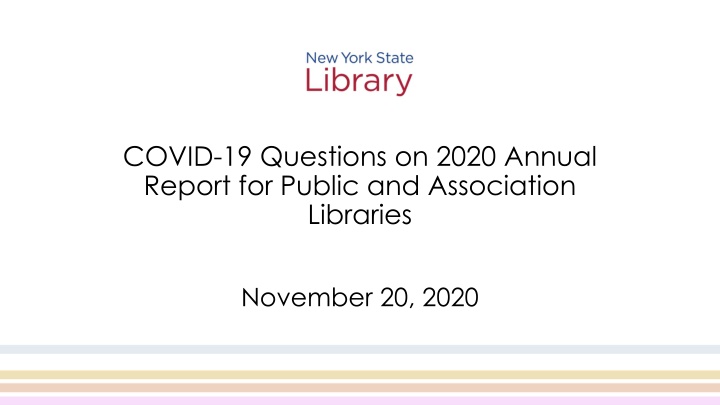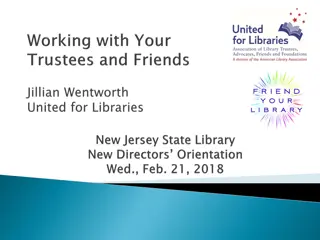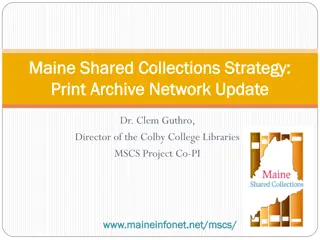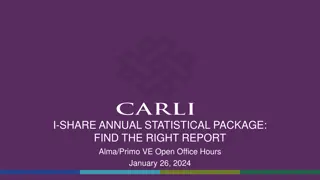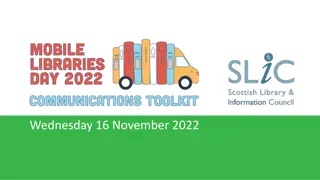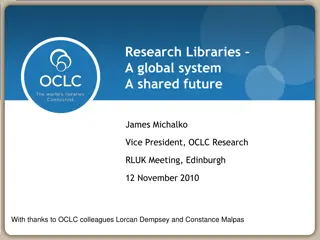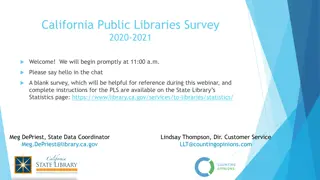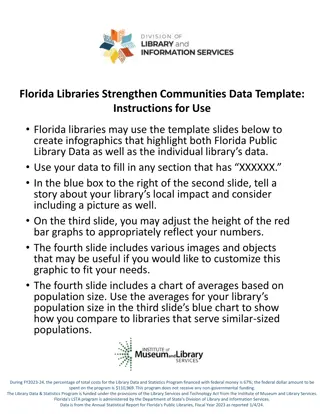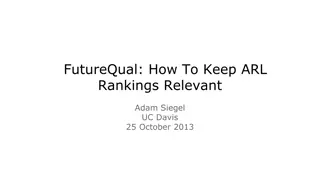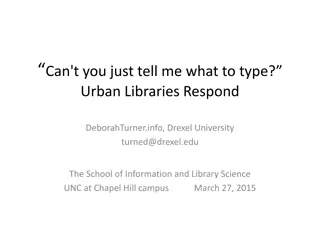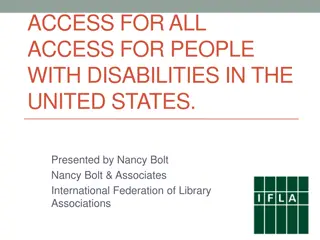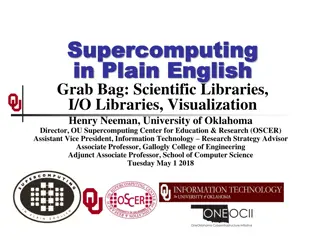COVID-19 Impact on Libraries: 2020 Annual Report Questions
The 2020 Annual Report for Public and Association Libraries introduces 15 new Yes/No questions to assess the impact of the COVID-19 pandemic. These questions, developed in collaboration with IMLS, AIR, and State Data Coordinators, focus on changes due to COVID-19, including virtual programs, recordings, and closures. Explore the evolving library landscape during the pandemic through these insightful questions.
Download Presentation

Please find below an Image/Link to download the presentation.
The content on the website is provided AS IS for your information and personal use only. It may not be sold, licensed, or shared on other websites without obtaining consent from the author.If you encounter any issues during the download, it is possible that the publisher has removed the file from their server.
You are allowed to download the files provided on this website for personal or commercial use, subject to the condition that they are used lawfully. All files are the property of their respective owners.
The content on the website is provided AS IS for your information and personal use only. It may not be sold, licensed, or shared on other websites without obtaining consent from the author.
E N D
Presentation Transcript
COVID-19 Questions on 2020 Annual Report for Public and Association Libraries November 20, 2020
Purpose and Overview The Fiscal Year 2020 Public Library Survey (PLS) data collection will include 15 new Yes / No questions developed to measure the impact of the Coronavirus (COVID-19) pandemic on public libraries and public library services across the United States. The Institute of Museum and Library Services (IMLS), the American Institutes for Research (AIR), and State Data Coordinators have collaborated on the content of these questions, which will be added to the 2020 NYS Annual Report for Public and Association Libraries.
Changes to the 2020 Annual Report as a Result of COVID 15 Yes/ No questions added to the Public Library Survey by IMLS One Yes/No Question added by NYS Library Live Virtual Programs may be counted in the Program Counts
Topic: Live Virtual Programs During COVID-19 Answer Yes or No to the following question: Did the library provide live, virtual programs via the Internet during the Coronavirus (COVID-19) pandemic? NOTE: Live, virtual programs are conducted via a Web conferencing or Webinar platform such as Facebook, YouTube, or Zoom, during which a library staff member (or other party sponsored by the library) is presenting to or interacting with an audience in real-time.
Topic: Recordings of Program Content During COVID-19 Answer Yes or No to the following question: Did the library create and provide recordings of program content via the Internet during the Coronavirus (COVID-19) pandemic? NOTE: Recordings of program content include video or audio recordings created by a library staff person (or other party sponsored by the library) and posted to a video or audio hosting platform for the audience to view or listen to on-demand. Do not include promotional or marketing content.
Topic: Closed Outlets Due to COVID-19 Answer Yes or No to the following question: Were any of the library s outlets physically closed to the public for any period of time due to the Coronavirus (COVID-19) pandemic? NOTE: An outlet is considered physically closed when the public cannot access any library buildings or bookmobiles, regardless of staff access. A building can be physically closed but still offer virtual, Wi-Fi, or curbside services outside the building.
Topic: Public Services During COVID-19 Answer Yes or No to the following question: Did library staff continue to provide services to the publicduring any portion of the period when the building was physically closed to the public due to the Coronavirus (COVID-19) pandemic? NOTE: Services to the public can include activities such as answering calls, emails, or texts with answers to information requests from the public; hosting virtual programming or recorded content
Topic: Public Services During COVID-19 (p. 2) NOTE: Services to the public can include activities such as offering curbside, delivery (mail or drop-off), or drive-thru circulation of physical materials; managing IT services to ensure external Wi-Fi access; and providing other types of online and electronic services, regardless of the location of library staff when they provided services (i.e., working from home or in the building that was closed to the public).
Topic: Electronic Materials Added Due to COVID-19 Answer Yes or No to the following question: Did the library add or increase access to electronic collection materials due to the Coronavirus (COVID-19) pandemic? NOTE: Adding or increasing materials can include increasing the concurrent or monthly borrowing limits for electronic materials, increasing the number of electronic materials and holdings,
Topic: Electronic Materials Added Due to COVID-19 (p. 2) or otherwise augmenting the public s ability to use electronic materials. These materials can include those the library did not pay for itself, such as those provided through the state library administrative agency, library consortium, or vendor at no cost in response to the pandemic. Types of electronic materials include e-books, audio and video downloadables, e-serials (including journals), government documents, databases (including locally mounted, full text or not), electronic files, reference tools, scores, maps, or pictures in electronic or digital format, including materials digitized by the library.
Topic: Electronic Library Cards Issued Before COVID-19 Answer Yes or No to the following question: Did the library allow users to complete registration for library cards online without having to come to the library before the Coronavirus (COVID-19) pandemic? NOTE: Online library cards provide users access to electronic collection materials and databases without having to be physically present at a library outlet to register for the card. Refer to the definition of Number of Registered Users (Q16.13).
Topic: Electronic Library Cards Issued Before COVID-19 (p. 2) Answer Yes or No to the following question: Did the library allow users to complete registration for library cards online without having to come to the library during the Coronavirus (COVID-19) pandemic? NOTE: Online library cards provide users access to electronic collection materials and databases without having to be physically present at a library outlet to register for the card. Refer to the definition of Number of Registered Users (Q16.13).
Topic: Reference Service During COVID-19 Answer Yes or No to the following question: Did the library provide reference service via the Internet or telephone when the building was physically closed to the public during the Coronavirus (COVID-19)pandemic? NOTE: Refer to the definition of Reference Transactions (Q4.18). Include references service provided via email, chat, and text.
Topic: Outside Service During COVID-19 Answer Yes or No to the following question: Did the library provide outside service for circulation of physical materials at one or more outlets during the Coronavirus (COVID-19) pandemic? NOTE: Includes any contactless or minimal contact provision of circulation items. Similar terms could include curbside, vestibule, or porch pickups, delivery (mail or drop-off), drive-thru, etc.
Topic: External WiFi Access Before COVID-19 Answer Yes or No to the following question: Did the library provide Wi-Fi Internet access to users outside the building at one or more outlets before the Coronavirus (COVID-19) pandemic? NOTE: Includes parking lot access, bookmobiles or other mobile facilities with Wi-Fi capabilities.
Topic: External Wi-Fi Access Added During COVID-19 Answer Yes or No to the following question: Did the library intentionally provide Wi-Fi Internet access to users outside the building at one or more outlets during the Coronavirus (COVID-19) pandemic? NOTE: Includes parking lot access, bookmobiles or other mobile facilities with Wi-Fi capabilities.
Topic: External Wi-Fi Access Increased During COVID-19 (pt 2) Answer Yes or No to the following question: Did the library increase access to Wi-Fi Internet access to users outside the building at one or more outlets during the Coronavirus (COVID-19) pandemic? NOTE: Includes parking lot access, bookmobiles or other mobile facilities with Wi-Fi capabilities. Increasing access could mean removing restrictions on sign-in authorizations, expanding router reach, leaving Wi-Fi service on 24 hours, installing or moving access points to promote or improve external access, etc.
Topic: Staff Re-Assigned During COVID-19 Answer Yes or No to the following question: Did library staff work for other government agencies or nonprofit organizations instead of, or in addition to, their normal duties during the Coronavirus (COVID-19) pandemic? NOTE: Include reassignments to other government agencies (e.g., to process unemployment claims), as well as other activities such as the use of library staff to distribute school lunches and other materials. Volunteering during work hours would count but volunteering off hours would not.
Topic: Number of Weeks an Outlet Closed Due to COVID-19 This is the number of weeks during the year that due to the Coronavirus (COVID-19) pandemic, an outlet building was physically closed, and the public could not enter, when it otherwise would have been open. NOTE: Round to the nearest whole number. If building did not close to the public due to the pandemic, enter zero. The sum of the Number of Weeks a Libraryis Open (Q9.16) and the Number of Weeks an Outlet Closed Due to COVID-19 should equal or be fewer than 52 weeks. An outlet is considered physically closed when the public cannot access any library buildings or bookmobiles, regardless of staff access. A building can be physically closed but still offer virtual, Wi-Fi, or curbside services outside the building.
Topic: Number of Weeks an Outlet Had Limited Occupancy Due to COVID-19 (p. 2) This is the number of weeks during the year that an outlet implemented limited public occupancy practices for in person services at the library building in response to the Coronavirus (COVID-19) pandemic. NOTE: Round to the nearest whole number. If building did not have a limited occupancy or similar practice due to the pandemic, enter zero. Weeks can be counted in both the Number of Weeks Library is Open (Q9.16) and the Number of Weeks an Outlet Had Limited Occupancy
Topic: Number of Weeks an Outlet Had Limited Occupancy Due to COVID-19 (p. 3) due to COVID-19 (that is, a library was open to the public and implementing limited occupancy practices in the same week). The Number of Weeks an Outlet Had Limited Occupancy Due to COVID-19 should not be greater than the Number of Weeks a Library is Open (Q9.16). Limited public occupancy practices can include reduced hours open, limits on the number of public members inside the physical building, appointment only on-site library use, visitor time limits, closed stacks or meeting rooms, etc.
Changes in Part 3 Library Programs in NYS Annual Report for Public and Association Libraries Due to COVID-19
Part 3, Library Programs, Policies and Services to include Live Virtual Programs Following discussion among State Data Coordinators, a consensus has been reached that the number of Live Virtual Programs may be included in Part 3 Programs questions. If libraries have numbers broken down by target audience, they can added to: (Q3.17) Adult Program Sessions, (Q3.18) Young Adult Program Sessions, (Q3.19) Children s Program Sessions, (Q3.20) All Other Program Sessions and (Q3.21) Total Number of Program Sessions.
Part 3, Live Virtual Program Attendance Following discussion among State Data Coordinators, a consensus has been reached that attendance for Live Virtual Programs may be included in Part 3 Program Attendance questions. If libraries have numbers broken down by target audience, they can be added to: (Q3.24) Adult Program Attendance, (Q3.25) Young Adult Program Attendance, (Q3.26) Children s Program Attendance, (Q3.27) All Other Program Attendance and (Q3.28) Total Program Attendance). For Live Virtual Program attendance, report unique or peak views. For Facebook, report one-minute views.
Part 3, Live Virtual Program Other Sections Similarly, if libraries have been collecting these statistics, libraries may include numbers of Live Virtual Programs and Live Virtual Program Attendance in these sections: Summer Reading Program, Early Literacy Programs, Adult Literacy Programs, ESOL (English Speakers of Other Languages) and Digital Literacy.
Additional NYS Annual Report Question - Part 3, Library Programs, Policies and Services Recordings of Program Content During COVID-19 Report total number of recordings of program content during COVID-19 pandemic. (Response is optional. Responses to new questions requiring numerical data may be estimated or left blank the first year.)
Total Number of Library Programs (Federal Data Element Definition) A program is any planned event which introduces the group attending to any of the broad range of library services or activities or which directly provides information to participants. Programs may cover use of the library, library services, or library tours. Programs may also provide cultural, recreational, or educational information, often designed to meet a specific social need. Examples of these types of programs include film showings, lectures, story hours, literacy, English as a second language, citizenship classes, and book discussions. Count all programs, whether held on- or off-site, that are sponsored or co-sponsored by the library. Exclude programs sponsored by other groups that use library facilities. If programs are offered as a series, count each program in the series. For example, a film series offered once a week for eight weeks should be counted as eight programs. Note: Exclude library activities delivered on a one-to-one basis, rather than to a group, such as one- to-one literacy tutoring, services to homebound, resume writing assistance, homework assistance, and mentoring activities.
Questions This Photo by Unknown Author is licensed under CC BY-SA
Questions from Systems - General General questions: Q. Is question 1.50 Unusual Circumstances going to be on the annual report this year and if so, how are you advising libraries to answer that? A. Q1.50 will continue to be on the report; Libraries should continue to answer this question regarding unusual circumstances other than COVID-19. That could include heavy weeding, a fire, flood, or other. Libraries should add a note if services were impacted by circumstances in addition to the COVID-19 pandemic. Q.I expect nearly every statistic that has to do with the general public (circulation, program attendance, hours open, visits, etc.) to change dramatically from 2019 to 2020. Can we assume that there will be more edit checks and requests for notes/ corrections as a result? A. There will be some disabling of federal edit checks that are programmed in the software. We will not be asking for the typical edit checks and you should see fewer requests for corrections and notes of explanation.
Questions from Systems budgeted for the fiscal year or the budget as it stood at the end of the fiscal year? Q. For Staff Information, the instructions ask for all positions funded in the library s budget whether those positions are filled or not. Some libraries in my system have amended staffing and budgets as a result of the shutdown. How should this information be reported? Is the intent what was originally A. The report should reflect the adjusted annual budget as approved by library trustees at the end of the fiscal year. A note should be added here if there have been large changes from previous year due to shut down. Q. How should a library count the hours open? A. The federal definition for hours open is used - which is hours that the building is accessible to the public, (regardless of staff access and other service provided.) An outlet is considered physically closed when the public cannot access any library buildings or bookmobiles, regardless of staff access. A building can be physically closed but still offer virtual, Wi-Fi, or "curbside" services outside the building. In that case a library should not count the hours open.
Questions from Systems (p. 2) Q. Are lobby services considered hours open? A. No, although the entry part of the building could be open for contactless service, patrons are not able to use the facility. In that way, Lobby services are considered similar to Curbside services and the hours that a building is accessible for Lobby Services only should not be included in Public Service Hours.
Questions from Systems- Programs Q. Should Live Virtual Programs be included the count of Programs in the Annual Report? A. Yes - Live Virtual Programs should be included in the Program Session counts (Q3.17, 3.18, 3.19, 3.20, 3.21) and Program Attendance counts (Q3.24,3.25,3.26,3.27, and 3.28). They can also be included in the subsections Summer Reading Program, Early Literacy, Adult Literacy, ESOL, Digital Literacy. Q. Should Recordings of Program Content be included in the count of Programs in the Annual Report? A. No - Recordings of Program Content do not meet the definition of a Program used in the federal Public Library Survey.
Questions from Systems (p. 3) Q. For the programming numbers you are asking for in the new COVID section, are those to be reported in the regular programming section as well? I.e., with the overall programming numbers, and with Summer Reading? A. The questions on COVID-19 should be included in the regular programming section where they already meet the definition of a program. Live Virtual Programs would be reported with the current programming elements (regular programming and Summer Reading). Attendance for Live Virtual Programs should be counted as unique or peak views. For Facebook, report one-minute views as attendance. Q. What about recorded virtual programs? A. The number of Recordings of Program Content should not be reported in program totals in the regular programming section or with Summer Reading. That question should only be answered as a new COVID-19 question. Recordings of Program Content are currently not considered to meet the federal definition of a Library Program.
Questions from Systems (p. 4) Q. Many of the platforms used for live virtual programs may have different background analytics and record participation differently. What is the definition of attendance ? Can you provide some examples? A. For counting attendance at Live Virtual Programs, count unique or peak views as attendance. For Facebook, report one-minute views. (Facebook Help) https://www.facebook.com/business/help/2993379508250 00?id=203539221057259
Questions from Systems (p. 5) Q. Regarding the virtual programming questions, our Library System has been collecting total virtual programming numbers (programs/attendance) on a monthly basis since March. However, we have not been asking libraries for a breakdown of live virtual programs versus recordings of program content. Please advise how best to handle. A. Since there hasn t been guidance up until now that distinguishes live and recorded virtual programming, if there is not a way to break the numbers apart, libraries may estimate as closely as possible. It may be possible to determine the live versus recorded in some cases by live viewers for the live, and remaining views for the difference that makes up the recorded programs. Q. What if a virtual program was live and then posted as a recording? Would you count it in both places? A. Yes - it would count as one live, and one recorded program.
Questions from Systems (p. 6) recording, but the audience is still interacting with the video and library through comments or engagements, do those also count as attendance under live? A. No - the social interactions under the recorded version would not be counted as attendance under the live. Q. What if a virtual program was recorded live, posted as a Q. Will you be looking for the number of views of the recordings? A. No the number of views of the recordings will not be collected this year in the Annual Report (but the system or library may wish to report that to their community separately.)
Thank you for coming! For questions, contact Jane Minotti Jane.Minotti@nysed.gov 518-486-4858
